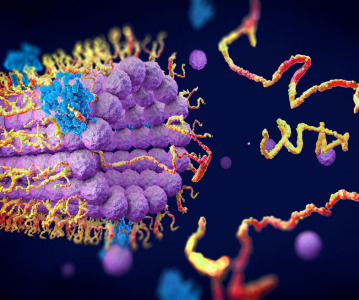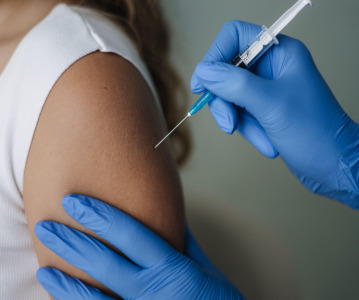FDA Approves Gazyva sBLA with New Data in Previously Untreated Chronic Lymphocytic Leukemia

Genentech has announced that FDA approved a supplemental biologics license application (sBLA) for Gazyva in combination with chlorambucil chemotherapy in people with previously untreated chronic lymphocytic leukemia (CLL). The sBLA adds to the label data from Stage 2 of the CLL11 study showing significant improvements with Gazyva plus chlorambucil across multiple clinical endpoints when compared head-to-head with Rituxan (rituximab) plus chlorambucil.
The approval includes complete response (CR) and minimal residual disease (MRD) data from Stage 2 of the study. Additionally, overall survival (OS) data was added from Stage 1 of the study comparing Gazyva plus chlorambucil to chlorambucil alone.
"Gazyva is the first and only medicine to significantly help people live without their disease worsening when combined with chlorambucil compared to Rituxan and chlorambucil in people with previously untreated chronic lymphocytic leukemia,” said Sandra Horning, MD, chief medical officer and head of Global Product Development. “These new data enhance our understanding of the disease and its treatment, and this approval affirms an important treatment option for people with this difficult-to-treat disease."
The sBLA approval updated the Gazyva prescribing information with the following data:
• Gazyva plus chlorambucil helped people with previously untreated CLL live nearly a year longer without their disease worsening or death (progression-free survival; PFS) than Rituxan plus chlorambucil (median PFS: 26.7 months vs. 14.9 months, respectively. HR=0.42, 95% CI 0.33-0.54, p<0.0001).
• Gazyva plus chlorambucil nearly tripled the number of people showing no evidence of disease (CR) compared to Rituxan plus chlorambucil (26.1% vs. 8.8%, respectively).
• Of the people who achieved a complete response with or without complete recovery from abnormal blood cell counts (CR, CRi), 19% (18/94) of people in the Gazyva arm compared to 6% (2/34) of people in the Rituxan arm were MRD negative in the bone marrow, and 41% (39/94) of people in the Gazyva arm compared to 12% (4/34) people in the Rituxan arm were MRD negative in the peripheral blood. MRD negative means no residual traces of the cancer were found.
• Data from the first stage of the CLL11 study showed that at nearly 2 years, the rate of death was 9% (22/238) for people who received Gazyva plus chlorambucil compared to 20% (24/118) for those who received chlorambucil alone (HR=0.41, 95% CI 0.23-0.74). The median OS has not yet been reached.
Gazyva can cause serious or life-threatening side effects including: Hepatitis B reactivation, progressive multifocal leukoencephalopathy (PML), infusion reactions, tumor lysis syndrome, infections, and low white blood cell counts. The most common side effects of Gazyva are infusion reactions, low white blood cell counts, low platelet counts, low red blood cell counts, fever, cough, nausea, and diarrhea.
Gazyva, the first medicine approved with the FDA’s Breakthrough Therapy Designation, was approved for use in combination with chlorambucil in people with previously untreated CLL on 1 November 2013. Gazyva, known as Gazyvaro in Europe, was approved by the European Commission for the same indication in July 2014. Gazyva is also being investigated in a broad development program across various types of blood cancers, including multiple Phase III studies in non-Hodgkin’s lymphoma (NHL).
Related News
-
News A Day in the Life of a Start-Up Founder and CEO
At CPHI we work to support Start-Up companies in the pharmaceutical industry and recognise the expertise and innovative angles they bring to the field. Through our Start-Up Programme we have gotten to know some of these leaders, and in this Day in the ... -
News Biopharmaceutical manufacturing boost part of new UK government budget
In their national budget announced by the UK Labour Party, biopharmaceutical production and manufacturing are set to receive a significant boost in capital grants through the Life Sciences Innovative Manufacturing Fund (LSIMF). -
News CPHI Podcast Series: The power of proteins in antibody drug development
In the latest episode of the CPHI Podcast Series, Lucy Chard is joined by Thomas Cornell from Abzena to discuss protein engineering for drug design and development. -
News Amgen sues Samsung biologics unit over biosimilar for bone disease
Samsung Bioepis, the biologics unit of Samsung, has been issued a lawsuit brought forth by Amgen over proposed biosimilars of Amgen’s bone drugs Prolia and Xgeva. -
News CPHI Podcast Series: Why we need to consider women in clinical trials
The latest episode of the CPHI Podcast Series with Lucy Chard covers women's health, specifically women's representation in clinical trials, the associated bias, and the impacts on health for this population. -
News US FDA does not approve MDMA therapy for PTSD, requests more data
The MDMA-based therapeutic developed by Lykos Therapeutics, a California-based Public Benefit Corporation (PBC), has been reviewed and unapproved by the US FDA. The regulator has requested additional phase III trial data for further safety and efficacy... -
News Novartis and Viatris latest facing lawsuit over HeLa cell misuse
Global pharmaceutical companies Novartis and Viatris are the latest hit with a lawsuit claim pertaining to alleged misuse of the ‘HeLa’ cell line from the estate of woman whose cancerous tissue cells were taken without consent. -
News Sanofi invests billions into Frankfurt insulin production site
French pharmaceutical company Sanofi have announced an investment of EUR1.3 billion at their existing BioCampus site in Frankfurt am Main for the expansion of insulin production.
Position your company at the heart of the global Pharma industry with a CPHI Online membership
-
Your products and solutions visible to thousands of visitors within the largest Pharma marketplace
-
Generate high-quality, engaged leads for your business, all year round
-
Promote your business as the industry’s thought-leader by hosting your reports, brochures and videos within your profile
-
Your company’s profile boosted at all participating CPHI events
-
An easy-to-use platform with a detailed dashboard showing your leads and performance



.png)

.png)
.png)
.png)